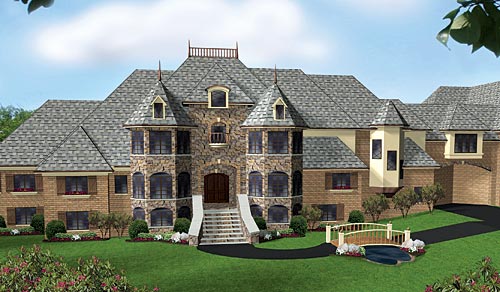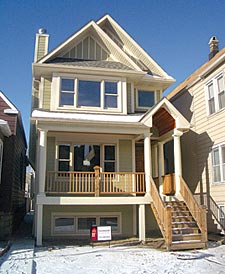All Wrapped Up Tight
A builder experiments with overlapping layers of insulation-as well as some other innovative measures-to help conserve energy in this extra-large house
 |
| St. Charles List price: $3.5 million |
The builder Robert Lord has used energy-saving techniques before, but for this 11,400-square-foot house northwest of St. Charles, he is using so many overlapping techniques that there is no immediate way to know exactly how much energy will be saved.
The dense closed-cell foam insulation packed between studs is supposed to save at least 50 percent on climate-control energy costs. A supertight insulating wrap on the exterior walls saves another 15 percent, and extrathick attic insulation another 15. What’s unknown is their cumulative effect. “This house is our lab,” Lord says. “We won’t know how much they save together until at least a year after the house is finished.”
A place this big would ordinarily have five furnaces and five air conditioners, Lord says. But thanks to a geothermal climate-control system-which pumps water belowground, where the temperature is in the 50s, and then circulates it through the home-this house will have just one unit (to heat up that circulating water in the winter and pump out hot air in the summer) and small air-handling machines to distribute temperature-controlled air throughout the 16 rooms.
The house is slated for completion this July. During construction, U.S. Recycling & Disposal of Plainfield will recycle an estimated 75 percent of the excess brick, wood, and other debris generated by the project.
Cost Cutters
Solar panels and efficient furnaces should keep energy bills from getting out of hand
 |
|
North Center
List Price: $1.25 million |
At 2,650 square feet, this five-bedroom house is about twice the size of its older neighbors. Yet, say its builders, this new residence should still have an energy bill comparable to those of the other houses on the block, given the solar panels on the southern part of its roof, two high-energy furnaces, extrathick insulation, and a tight insulating house wrap.
Because most buyers aren’t yet willing to pay more for those low-energy features, the additional costs-from $10,000 to $15,000, says Chuck Ginsberg, a partner in Solfire Homes-will come out of the builders’ profit margin. “We’re trying to build awareness that these features are worth having,” says David Konopacki, Solfire’s other partner. “Energy prices are getting to the point where people will be asking for these things.”
For three years, Ginsberg and Konopacki have been building progressively more eco-friendly homes, including a similar North Center house that sold for about $1.2 million this past September. (Both houses use sustainable Hardie Plank siding, which looks like traditional wood siding but is actually composed of a concrete-like material made from water, sand, and a fast-growing renewable wood fiber.) Next up, they say, is another house in this same neighborhood with geothermal heat, a system rarely used on narrow city lots.
Eco-Economics
What are the eco-friendly adjustments you can make to your home that will show the best return should you decide to sell? Celeste Karan-a Keller Williams agent in Lincoln Park who recently taught a “Green Home 411” seminar at the Chicago Center for Green Technology-has several recommendations. Owners can significantly reduce energy waste, she suggests, by adding insulation and energy-saving windows, and replacing old appliances with energy-efficient models carrying the Energy Star label (for more information, go to www.energystar.gov). They can also enhance indoor air quality, she says, by replacing carpeting with wood floors made from renewable sources (such as bamboo) and protected by water-based sealants. Bigger fixes-such as installing solar or geothermal systems-“are wonderful things to do,” Karan says, “but they don’t pay back at resale time, unfortunately.”
Illustration: Realistic Renderings, Inc., Courtesy of Robert Lord Builders, Inc. Photograph: Dennis Rodkin



